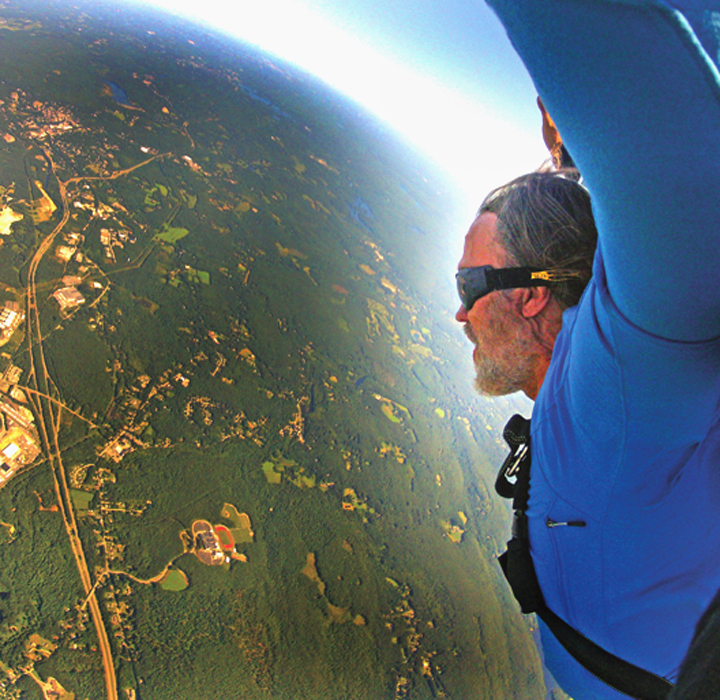Celebrating 20 years of publishing The Waterbury Observer, John Murray decided to leap out of an airplane 10,500 feet above Connecticut. The plunge reminded Murray that launching a business with no money, or chasing dreams of world travel all have one thing in common, facing fear, and letting go.
Story By John Murray
Photographs By SkyDive Danielson
For most of the twenty-minute ascent I tapped into breathing exercises, and positive imagery, to try and keep myself calm.
“That’s the University of Connecticut,” said Norm Nault, my tandem skydiving instructor, “and if you look to the south you can see Long Island Sound.”
At 5000 feet my attempt to relax faltered, and the metallic taste of fear marched across my tongue. I looked around the plane – which was no bigger than a car – and checked on my daughter, Chelsea. If I was starting to lose it, I was sure Chelsea’s heart was clanging against her chest. Chelsea was tandem jumping with instructor Scott Barylski, a dead ringer for actor Ben Stiller. There was something comical, and terrifying, about hurling yourself out of a tiny airplane with Derek Zoolander strapped to your back.
Gallow’s humor is under rated. Derek Zoolander (one of our favorite movie characters) and the 12-page release form we had filled out provided plenty of chuckles for Chelsea, me, and Troy Michaud. Troy is my personal trainer at the Poundstone Gym in Waterbury, and it was his bright idea to plunge towards Earth at 120 mph.
It all began with, “Hey John, you want to go skydiving this weekend?”
In the summer of 2012 Troy talked me into signing up for a Tough Mudder, an 11-mile race up a mountain, and through 30 obstacles, including leaping over fire, plunging into a pond of ice, getting electrocuted, and crawling through a field of mud inches beneath barbed wire. I ended up straining my Achilles tendon before the race, and never made it to the starting line.
Since skydiving involved no training – just a sense of adventure – I immediately said yes. I recruited my 25-year-old daughter, and in what felt like a nano-second, we were initialing a waiver of liability contract releasing SkyDive Danielson of all responsibility for the “unpredictable risk of permanent injury, pain, suffering, and death.”
We watched a short video and were repeatedly told not to grab the instructor’s hands and arms during the jump, or we’d die.
The plane could only hold the pilot and four passengers, so Troy went first with his instructor and two solo skydivers. We wished Troy well, and made sure we knew where the keys to his car were, in case he didn’t make it back.

Troy Michaud
With Troy in the sky, and our feet still squarely on the ground, we peppered Chelsea’s instructor with questions. Scott explained the psychology of getting terrified clients to jump out of an airplane, and he told us he had a reputation for making clients vomit. During one memorable free fall, with Scott attached to his back, a middle-aged man urinated on himself while hurtling towards Earth.
We watched in awe as Troy and his tandem instructor floated towards us and landed 50 yards away. Troy had a huge smile on his face, gave us a couple of high fives, and then it was our turn.
Five of us shoehorned into the airplane, and without a peep from either Murray, we were airborne. I watched the trees and grass grow smaller, but my eye kept going back to the pilot, Thomas Griffiths, who looked like he had just graduated from high school. Under his profile on the SkyDive Danielson website it said he had his commercial license for single & multi engine aircraft. Beneath each staff bio it listed how many jumps they had performed. The co-owner of the business had more than 9000 jumps, but beneath our pilots name it said one.
I began to think he was the only sane person in the airplane.
The higher we climbed, the less effective my meditation techniques became. At 5000 feet my ears popped, and fear began its dance inside my skull.
What if the parachute didn’t open? What if my instructor hit his head on the wing and was knocked unconscious? How was Chelsea doing? What if we landed in a tree….
Minutes later the plane engine throttled back, the passenger door I had been leaning against slid open, and I was on my knees peering 10,500 feet down on the green fields of eastern Connecticut. With Norm attached to my back, I had to contort to dangle my feet out of the airplane while sitting on the lip of the plane’s interior.
The wind tugged at my legs, and the skin on my face morphed sideways towards Long Island Sound. My instructor wiggled into place, and the banter inside my head vanished as I waited for the signal to begin our plunge.
At this point, with my body half out of the airplane, there was no turning back. I surrendered my fate to the Gods, and to my instructor, who I prayed added one more successful jump to his resume. And with that, we tumbled out of the airplane.
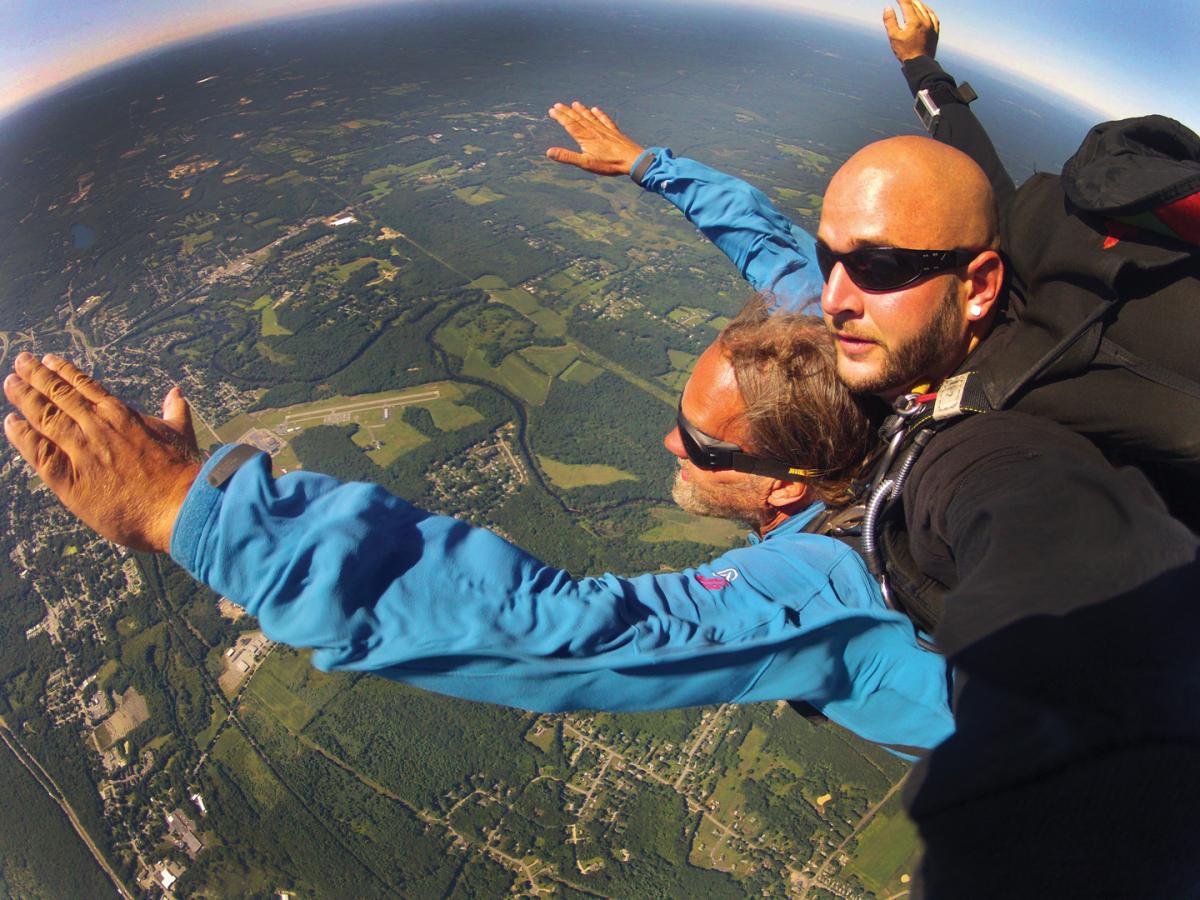
Waterbury Observer publisher, John Murray, left, soars above Connecticut under the watchful eye of skydiving instructor Norm Nault.
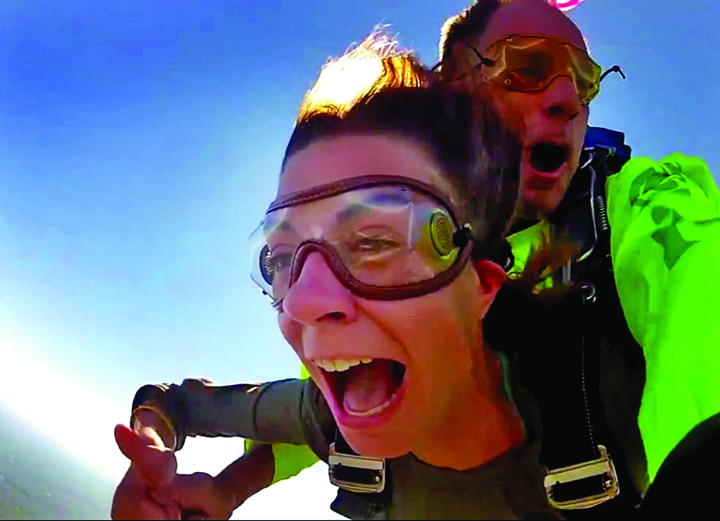
Chelsea Murray, who has a fear of heights, overcame a mountain of doubt to hurl herself out of an airplane.
The Beginning
Launching the Waterbury Observer in 1993 was a lot scarier than leaping out of a tiny airplane 10,500 feet above Connecticut. When I went skydiving I was attached to an expert with 1100 successful jumps on his resume. When I launched the Observer with Marty Begnal in September 1993, there were no parachutes as we hurled ourselves into the unknown.
It was learn to fly, or splat.
I was recently divorced, had a five-year-old daughter who depended on me, and lived in a depressing apartment above a deli at the bottom of Bunker Hill Avenue. My goal of travel writing had been derailed by a mix of love and fear, and my ex-wife’s single-minded focus about living her life in Waterbury, two blocks away from her parent’s house.
Dreams can perish on the sharp edges of reality, or they can find safety in the corners of the mind, lingering, waiting for opportunity. My dream of travel writing did not die, and was critical in the formation of The Waterbury Observer. The newspaper was Marty Begnal’s idea. Marty was born and raised in Waterbury, and he dreamed of covering local politics, and growing old in the city he adored.
I am not from Waterbury, and I dreamed of launching a newspaper to have 100% control over my words and photographs, to use the business to raise my daughter, and to transition myself into a career of travel writing. Marty and I agreed that while I was raising my daughter I would unleash my words and photographs on Waterbury, and slowly begin to step out and explore the world.
We worked insanely long hours for very little money, and after two and half years, Marty left the Observer to pursue other interests. Suddenly I was the sole owner of the Observer, and my dream of travel writing seemed more elusive than finding Bigfoot in the forests of the Pacific Northwest. I soon learned that owning and operating a small business is a daunting challenge, particularly if your product is words and photographs, and your interest is fueled more by ideas, than money.
Realizing I had a unique opportunity to bend the Observer around the responsibilities of being a single parent infected with wanderlust, I committed myself to Waterbury, and making the Observer a community asset.
And, I would use the newspaper to go on wonderfully long adventures with my daughter, which in reality was blending my business, my family, and my dream into one eclectic, multi-tasking adventure. We started when she was seven years old with a 5000-mile road trip to Colorado and Montana in a battered silver pick-up truck with a wooden bumper. I was broke, but we cashed in $950 worth of coins at Webster Bank, and hit the road.
We camped out, fixed our own meals on the fly, and became best travel buddies. We talked all day about geology, Native Americans, Disney movies, history, clouds, animals, and anything that popped into our heads. The road trip was a three-week conversation with my daughter, and changed both of our lives.
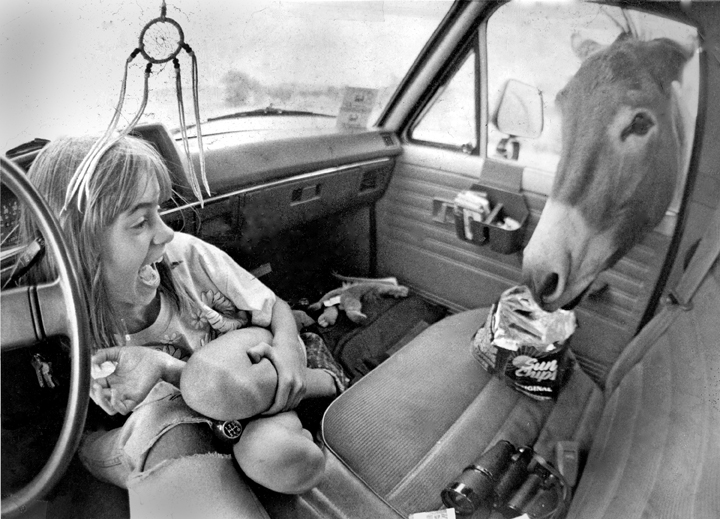
Chelsea Murray screamed in delight when a wild donkey in Custer State Park in South Dakota jammed its head into her truck druring a long distance road trip with her father, John Murray.
And for the next dozen years, August became our time to explore. The next year we drove 10,000 miles to Alaska on an epic road trip across Canada, through the Pacific Northwest, and back across the continent to Connecticut. We were gone for a month, and although I was uncertain I would still have a business when I returned, I had to go.
And go we did. During the next dozen years we explored California, Hawaii, Mexico, Guatemala, England, Scotland, Ireland, Greece, Turkey, India, Hong Kong, Thailand and Singapore. After every trip I wrote about the adventure in the Observer, and further detailed solo trips to Israel and Nicaragua.
The travel pieces became a staple of The Waterbury Observer, and although some readers complained that I was out of touch with the community, many others loved reading about our adventures with pirates in the Straits of Malacca, hiking up a live volcano in Gutemala, or searching for Chelsea’s maternal grandmother in Greece. And while we was traveling, I was out of touch with Waterbury – wonderfully out of touch – but the adventures strengthened me, and allowed me to return to Waterbury, and continue the newspaper.
Chelsea is now 25 years old. She graduated from Marist College with a degree in International Communications, and is blasting off to Europe on September 30th on a “indefinite” exploration. She and her boyfriend, Michael Kaneb, are going to live and work on a network of organic farms starting in Germany, and working their way through France, Spain, Portugal, Italy, Albania and Greece. They may be home in a month, they may be home in six months, or they might work their way around the world and come back when they are ready.
Chelsea will report about her adventures for the Observer, as she has done since she was 12 years old, and I hope to intersect their trip in December to work on my Spanish. I am thrilled that my daughter has the courage to shuck societal expectations, and explore herself, and the world around her.
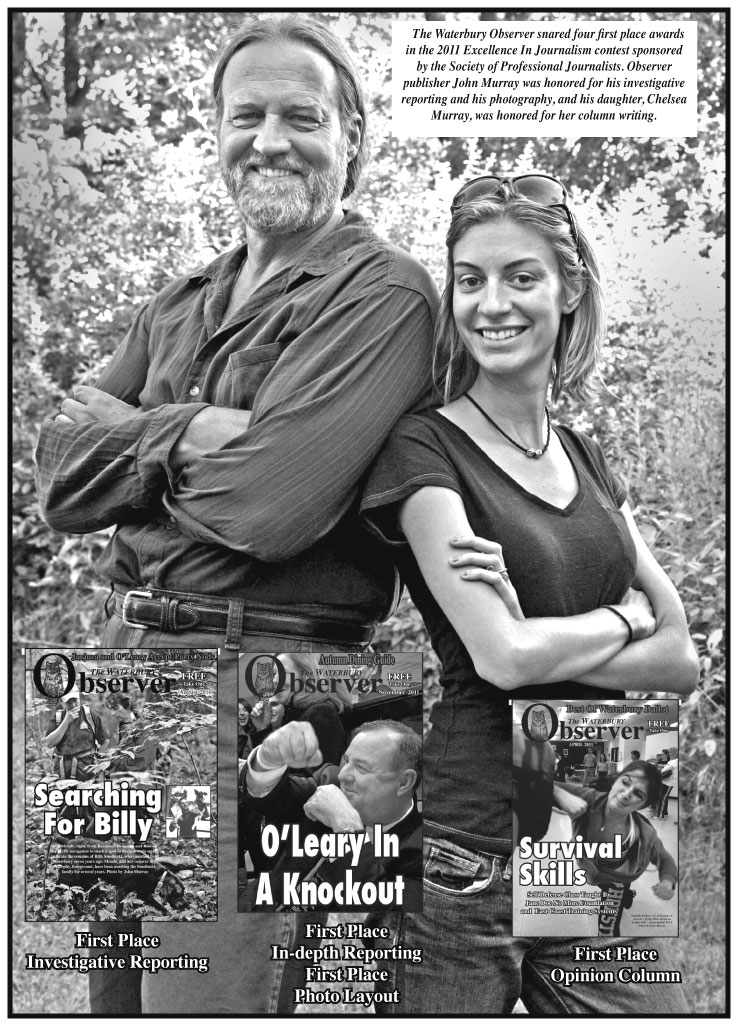
In one form or another, John and Chelsea Murray have worked together at the Observer for 20 years. Chelsea was five years old when the newspaper started, and she stood on the corner of Bank Street and Grand Street in downtown Waterbury and handed out the first issue to strangers. She came along for interviews with Mayor Bergin, Governor Rowland, and has had the opportunity to meet Bill Clinton, George W. Bush, Barack Obama, and a slew of interesting and colorful people.
As I blow out the candles on the 20th anniversary cake of this newspaper, I am left to ponder my own future. The business of journalism has radically changed since 1993, and I had to change with it. When we started the Observer I didn’t know how to use a computer, there was no Internet, we didn’t have cell phones, and pictures were shot on film, developed in my bathroom, and printed in a closet.
At various times in the newspaper’s history I have relied on many other people to help produce the Observer. It was launched by two knuckleheads with a dream, grew to a staff of twelve, contracted to a staff of two (myself and Maureen Griffin), and is now basically just me. I have several wonderful columnists who provide monthly content – Jim Szynkiewicz, Carl Rosa, Reggie Beamon, Sondra Harman, Kevin Zak and Jim Miller, but I write the feature stories, take the pictures, sell most of the ads (Chelsea and Kevin Zak still help out), make the ads, produce the paper, and deliver the newspaper at 300 locations around greater Waterbury.
Additionally, in the past several years we’ve launched a website www.waterburyobserver.org, and established a solid presence in the social media world of Facebook, and to a much lesser degree, Twitter. Instagram, Pinterest and a slew of other social media applications remain a complete mystery. And while the printed version of the Observer comes out once a month, the website and social media allow the newspaper to be relevant on a daily basis. And on occasion the website has allowed the Observer to scoop the Republican-American newspaper with an important story that the printed edition would never have allowed us to do.
While I still derive almost all of my income from the print edition of the Observer, the future of journalism is online, and in 2014 the Observer will begin an aggressive migration to the Internet. To start, there will be fewer issues printed and distributed in greater Waterbury, and there will be an intensified effort to transition our readers and advertisers to the website.
The price of printing the newspaper continues to rise, and within a few decades printed newspapers will be extinct. It’s move online, or eventually go out of business. The heavyweights of journalism, The New York Times and The Washington Post, have both experienced difficulty in making their online business models profitable. The Observer is not a journalism heavyweight, but it is vastly more fluid than most newspapers since it is produced by one individual, and the cash flow only needs to feed one person.
There are several months during the year when the Observer makes no profit in its printed edition, and these issues will not be printed in 2014. Eventually the only print issues will be the Best of Waterbury, and the annual City Guide, and everything else will be online.
Of course there is huge risk involved, and many of our older readers who are computer challenged will no longer have access to the articles and photographs. On the flip side, however, a new generation of consumers must be engaged. And as the Observer evolves into a more vigorous online resource, there will be more information available without worrying about the exorbitant cost of print and distribution.
And, most alluring to me, I can upload information on the website and produce a digital Waterbury Observer from anywhere on the planet. In 2014 the Observer will attempt to conduct business from New Zealand during the month of February, and from Italy and the Balkan Peninsula in July and August.
For two decades the printed Observer has been a unique blend of community journalism, and travel writing. By going online the community journalism will intensify, and by having greater flexibility in my life, so will the travel features. The looming question is whether readers and advertisers will follow the Observer online? Will a digital business model work? I’m not sure, but I’m determined to find out.
The community has supported this zany adventure for 20 years, and I suspect the community will continue to do so as long as the Observer continues on its mission of providing quality journalism. And I’m hoping Observer readers will bear with me as I go bonkers for a few years sailing and exploring the globe.
In the end, it’s kind of like jumping out of an airplane from 10,000 feet, you have to let go of uncertainty and fear – surrender – and leap.
The Descent
As we tumbled out of the airplane I arched my head to the sky, and my instructor rolled us backwards 360 degrees. At one point I saw nothing but the plane, clouds, and an endless ocean of blue sky.
Within a second we were headed face down towards Earth at 120 mph. My ears filled with the roar of rushing wind, and I began to scream. It wasn’t a scream of terror, but rather a scream of joy. It came from somewhere deep inside me, was totally spontaneous, and continued for 45 seconds as we plumeted towards Earth.

I believe there were several forces behind that scream;
• I was rejoicing at the accomplishment of keeping the Observer alive for 20 years.
• I was unlocking the dream of travel writing that has simmered inside me for 30 years.
• I knew the time had come to transition the newspaper into the digital age.
• I am boundlessly happy that my daughter is in a great place in her life, and was about to launch herself into an excillerating adventure.
But the foundation of that scream came from the realization that for me to continue to grow, to be fully alive, that I have to live on the edge of change, and plunge into the unknown. I know I can survive taking photographs and writing, but the future of this newspaper, now more than ever, is in the hands of the readers and advertisers of The Waterbury Observer.


